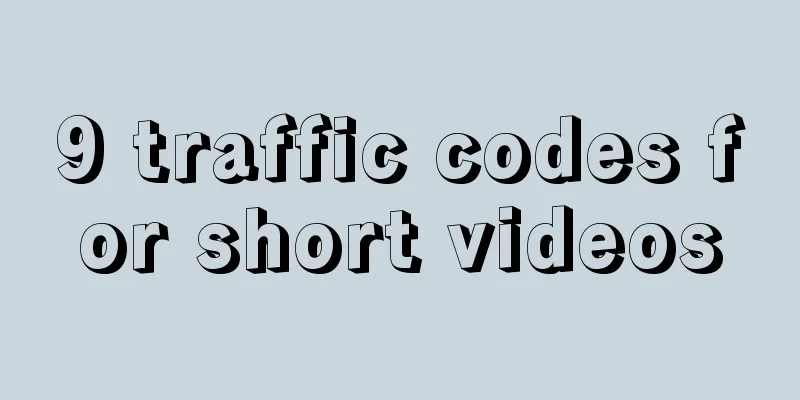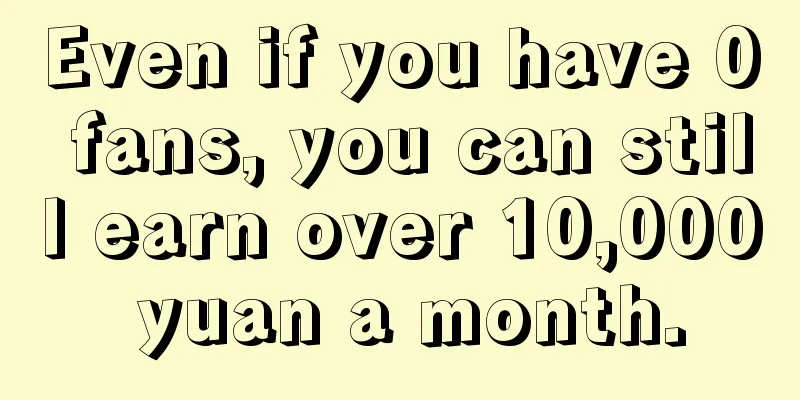Find the breakthrough point, it depends on the number one position

1. Business: Occupy a position of your ownWhat is not in the cognition is more important than what is on the shelf. Because only when the cognition is empty, we have the opportunity to seize a position, business = position. The so-called business opportunities objectively exist in the subjective cognition of consumers. You have to look at the market from the outside, define the business from the outside, shape the product value from the outside, and even spread information from the outside. The process of insight, discovery, and occupation is the process of doing business. When consumers have category awareness but no brand awareness, the biggest vacancy is to occupy the category vacancy and let the brand endorse the category (brand = category). If you give up the opportunity to enter the endorsement category first during this period and go toe-to-toe with the so-called competitors, you will essentially make a big mistake - you win the battlefield but lose the battle, and miss the battle momentum. 2. Operational decisions are more important than management decisionsThinking from the perspective of categories is the first step in doing business. Categories are the matrix, the market and the foundation of business. Only a rich matrix of categories can breed strong brand vitality. Therefore, the category behind the product is the driving force of business. It is said that it is good to lean on a big tree for shade and a pig standing on the wind will fly. Big trees and wind outlets are actually new categories and new opportunities. Operational decisions are more important than management decisions; you cannot rely solely on management efficiency to solve operational problems. As an entrepreneur, the first decision-making efficiency is to: see and discover opportunities to create new categories of business. That is: there is basic knowledge of the category in the market, but it has not yet been occupied by a strong brand in the minds of consumers. 3. Improving product strength means eliminating the selling pointThe essence of differentiated competition is to form differentiated cognition on the consumer side, guide facts through cognition, and strengthen cognition with the help of facts. On the one hand, it is the factual differentiation support at the product level, and on the other hand, it is the cognitive segmentation of consumer differentiation. The method is to focus on categories, create super appearance, and launch super hot products, thereby forming a strong cognition in the minds of potential customers. Otherwise, the more products there are, the less focused the cognition will be, and the less money you will make. Facing the competition from Yakult, which is the No. 1 in market share, Wei Chuan found a common sense point in the category: "0 fat" quickly occupied the market; it unexpectedly became the second place, followed by Mengniu and Yili. In fact, all lactic acid bacteria are fat-free, and 0 fat products are a common feature of the entire category, not a unique feature of Wei Chuan products. Similarly, 99% of beverages are fat-free, but Yuanqi’s insight into consumers is not the two zeros of zero sugar and zero calories, but the nonsense word zero fat. The core of differentiation is the subtle insight into the user’s needs and whether you have found that point and regard it as the core differentiation in communicating with consumers. 4. Branding is essentially a businessLet's look at the brands we are familiar with, such as Coca-Cola, Starbucks, and Nike; for example, today's new consumer brands, Ramen Say, Santonban, and Zhong Xuegao. Behind each brand, there is a business.
Behind every brand, there is a business. The essence of a brand is a business; or in other words, the essence of a brand is to discover and create a business. Therefore, for a brand manager, how to understand the business is a logic that transcends the brand. 5. Pricing: Seek the situationYou can naturally use the price that suits your position. On the contrary, if you are not in that position, you cannot set that price. It is not that you cannot set it, but that consumers do not accept or approve of it because you do not have that potential energy. Price is potential energy. A good fighter seeks it from the potential energy, not from others. Therefore, he can blame others and take advantage of the potential energy. In fact, compared with the cost, consumers are more concerned about the benefits of purchasing products. Including: use value, functional value, image value, and social value. The logic of pricing has never been cost, but creating advantage recognition and price anchoring. If we use Bai Xiaot's logic:
6. Deliver unique value and give consumers clear reasons to buyFirst, there is the insight into demand. Only with the insight into demand can there be the insight into competition. Finally, there is the technique of words. Advertising words serve the product and assist sales. The core is to convey the question of why to buy your product. Without the insight, advertising is just wild creativity. Creativity cannot be copied. Advertisers are not artists, but craftsmen. They start with demand and end with the reason for purchase.
7. Selling Point FormulaIn early markets, where almost all purchasing decisions are made by technology enthusiasts and visionaries, the primary value areas are technology and product - Crossing the Chasm. Select ( ) with ( ) function, satisfy ( ) interests, so. When a new brand is first launched, with limited funds, it is first to break through with a single point, and there is no need to make a lot of selling points and features. Focus on breaking through in product strength, and find a differentiation point (single point) in product strength (function-benefit). From craftsmanship, ingredients, components, to functions, do subtraction, sharpen the interest point - profit from one hole. In terms of publicity, we should insist on producing quantity first, spreading the word first, and concentrating on one media platform. Quantity comes first and quality comes later. Without quantity, there is no quality. At this stage, we divide our forces (multiple platforms), and the originally limited resources are spread into a thin cookie. If we prepare for the left, we will have less resources on the right; if we prepare for the right, we will have less resources on the left; if we prepare for everything, we will have less resources on everything.
8. User PerspectiveWe have never understood consumers so well as we do today. In the past, consumers’ self-portraits were based on region, occupation, age, and income. Today, there are labels for consumers’ self-portraits that you can’t imagine: small town youth, sophisticated moms, otakus, technology geeks, ingredient parties - wherever they go, they will leave traces. Multi-dimensional consumer labels mean that new brands have more dimensions to describe and reach potential consumers. For brands, the long-tail effect of 1 million fans is 10 million sales. Content, traffic, fans, and monetization, from 2015 to 2021, every change in traffic has brought a new brand iteration. Content + traffic has become the only way to achieve the 0 to 1 stage of new consumer brands.
5A: From the perspective of consumer behavior, describe the strength of the behavioral relationship between consumers and brands.
Brands expose, reach, interact, convert, settle, and activate target consumers by initiating actions (pictures, texts, short videos, advertisements, news, etc.). In this process, the behaviors of users are triggered from the exposed group, the shallowly interacted group, the deeply interacted group to the purchasing group and the fan users. Always, we focus on the interactive relationship between users and brands and understand brand actions. We reach the right people in multiple dimensions and multiple times, thus triggering consumer behavior and bringing the interactive relationship between the brand and target consumers closer, from understanding, attracting, to asking, taking action, and repurchasing. 9. Extremely absurdCreating a bigger, more complete, and better company to surpass competitors is like throwing an egg against a rock for a startup. Startups should maximize a single factor, focus on the most critical single factor, and concentrate their superior strengths to make a breakthrough.
Because the extreme absurdity generated by a single factor is the easiest to trigger strong memories and goodwill among users, and it is also the easiest to establish popularity and open up relevant mental connections among users. Once this kind of traffic returns, its brand will inevitably benefit. The key to a company's success lies in "maximizing a single factor." That is, the company should focus on a core factor of the first curve, invest heavily in resources, identify the breakthrough point through the 10-fold change of a single factor, and then invest all resources to maximize the single factor and break through the threshold. This requires the founder's judgment and execution.
10. Breaking pointAny product must have only one core function, not a variety of optional functions. The more you talk about functions that are neither good nor bad, the more mediocre the product becomes. Mediocrity actually means that you haven't found the real point. If you can't find that point, you can't break the situation and open up the situation. Breaking through the situation must be coordinated with the general direction, points, lines, surfaces and bodies, and establish a big picture of the single product leading system. Former Apple CEO Sculley proposed a term called (zoom in) abstraction and (zoom out) focus, looking at the direction and trend of the entire industry from a high level, which is the direction of the battle, and the latter is to focus on a single point to break the battle situation. He can see the battle situation and sink into the game, start the game, and break the game. There are few people in the world who can perfectly combine these two. Fortunately, we are an organization, and the chairman's talent and the general manager's strategy can complement each other. 11. Three Origins of the MarketThe origin market, the origin crowd, and the origin channel are a process of mutual emergence. Through the origin crowd, the origin channel can be clearly identified, and then the origin market can be found in the process of continuous superposition of the origin crowd and the origin channel. Sometimes the market is a general concept. To be precise, market = channel + crowd. In the process of 0 to 1, the first thing to understand about the market is the origin crowd. That is, to have a clear portrait of the origin crowd. The so-called origin crowd portrait is not just about age, gender, income, and education, but more about the behavior, preferences, and catalyst habits of the origin crowd. In other words, the significance of the origin crowd is:
By understanding the real consumers, we can gradually understand how consumers buy, why they buy, where they buy, and how they use them, and then gradually improve and establish a clear initial market cognition. Once this initial cognition is established, the subsequent source channels will gradually become clear. Even vice versa, the product publicity, media, promotion, pictures and texts, and KOL placement will also be targeted. The logic of people, goods, and places is to go from the origin crowd (people) to the origin channel (place), and then achieve the matching of people, goods, and places, and find the origin market. Then establish and build a model market, and gradually establish a base. From 4P to three origins, then to model market, and then to base construction. Origin market = Origin crowd + Origin channel. Origin market is not an independent concept, but grows out of the continuous superposition of origin people and origin channels. That is: through the origin crowd, clarify the origin channel; through the origin channel, amplify the origin crowd. As the origin crowd and the origin channel are continuously superimposed, the origin market gradually becomes clear. After the origin market is clear, we select the most exemplary market based on sales data and users as the strategic target market. The significance of the strategic target market is that it can be grown, quantified, and replicated, and it can prepare data, strategies, and models for entering the mainstream market later. In addition, when there is no clear portrait of the origin group, premature brand emotional publicity will attract non-origin groups. At this time, it is often difficult to sustain after a wave of sales. We still have to go back to the origin group and find the brand's tone through the portrait of the origin group. Brand tone is not the personal preference of the brand manager, but the discovery, excavation and sublimation of the emotions and feelings of the origin group. 12. Coverage PossibilityPossibility of coverage: through what channels, media, advertising, and public relations can potential customers be covered. This is a question of the communication scope after the consumer's self-portrait. When talking about precise coverage, it is also precision under the premise of quantity. Without quantity, there is no quality. To achieve quality, you must first ensure quantity. This sentence is the same for coverage. For example, Xiaoxiandun focused on weight loss and skin care in 2018; in 2019, it enhanced the concept of pregnancy care and anti-aging, and increased the percentage of skin care products from 28% to 45%. This means that the combination of skin care and function is effective. After April 2019, the scenarios for Xiaoxiandun's advertising began to change. The proportion of "weight loss" scenarios decreased to 11%, and the proportion of "skin care" scenarios was the highest, accounting for more than 45% of the total. The proportion of "pregnancy care" and "freezing age" scenarios increased significantly, and the proportion of "health preservation" scenarios was still at the bottom. After 2020, we will increase awareness through super head + KOL placement. Select Zhang Yuqi, Zhang Ziyi, Jing Tian and other celebrities with the labels of "noble lady" and "exquisite" to promote Xiaoxiandun, which not only brings high exposure to the brand, but also subtly establishes the credibility of potential consumers for Xiaoxiandun. We used "weight loss", "skin care", "anti-aging", "health care", and "pregnancy care" as keywords for penetration, and gradually came up with core keywords: skin care as the main focus, health care as the foundation, pregnancy care, and anti-aging as the grass-planting strategy for penetration of the population. We did this through cross-border marketing, brand co-branding, seizing new dividends of stage traffic, creating momentum, public relations, and advertising. We achieved multi-dimensional and multi-scenario reach and coverage of the population and the general population. 13. Dare to be the last in the world and find a benchmarkDiscover first, then invent. Objectively speaking, anything you can think of has already been thought of or even done by someone in this world. This world has never been and will never be able to achieve the so-called "flat state". The successful businessmen compete on who can be the first to find the information gap. Only in an industry where others are doing well, you have the opportunity to do better. The core of business decision-making is all in after the choice, not the choice after all in. Don't forget the basic probability of anything. The probability of an event happening is equal to = basic probability * the probability of the event itself. Category is the foundation and ceiling of business. In a declining industry, you can't escape from the ascension - the basic plate of the category largely determines the probability of success or failure. For example: In Yuanqi Forest’s products, you can almost find the shadow of its products in another business society. Whether it is burning tea, sugar-free sparkling water, milk tea, or electrolyte water, the success that has been verified in a market after daring to be the best in the world is often more likely to succeed, or has a greater probability of success. Sugar-free tea has a high penetration rate among Japanese consumers. Yuanqi Forest Beihai Ranch Yogurt corresponds to the American Greek yogurt brand CHOBANI. CHOBANI's sales exceeded 1 billion US dollars in 5 years. Alien Energy Drinks is benchmarked against Monster, which challenged Red Bull's absolute leader status and became the most dazzling company in the American food and beverage industry since the 21st century.
14. Misaligned CompetitionFacing the strength of the first mover, if the latecomer competes with the first mover in the same dimension, it is tantamount to hitting a rock with an egg. In the history of business, there are almost no cases of launching a direct challenge to the leader and winning. The core of misaligned competition is to find your own ecological niche in the industry, choose different elements from the first mover, and then achieve a breakthrough in the new track. After the melamine incident, "safety" became synonymous with overseas milk powder. If domestic milk powder still competes with overseas milk powder on the dimension of "safety", it will never gain an advantage. This is not a problem of product quality, but the sequelae of consumers' "mental trauma", which cannot be cured by a brand. Among many domestic milk powders, Feihe has taken a different approach and broke the deadlock by claiming that it is "more suitable for the physique of Chinese babies", which is obvious common sense. Facing the strong position of Yili, Mengniu and Bright in the ambient temperature milk market, Jane Eyre chose low-temperature milk (yogurt) as its entry track and found a breakthrough point by focusing on new channels. The traditional method of selling yogurt is basically to sell it in KA supermarkets and traditional small stores. With the help of new channels and misaligned competition, it has seized the cognitive gap and become the leading brand in the subdivided category. 15. Price vacancies
Mixue Ice City adheres to the strategy of low price and "surrounding the city from the countryside", which not only breaks the situation but also creates a new situation of 20,000 stores. From the perspective of the industry price range, Mixue Ice City has locked in low prices, but from the perspective of specific consumption, it is difficult to say that it is not a consumer upgrade for people who have always drunk beverages to now drink milk tea because of Mixue Ice City. Low-end disruption is not the only way, especially at the current time of consumption upgrading, many new consumer brands have achieved industry breakthroughs by positioning themselves at high prices, and even brought dividends to the entire category, such as the new consumer brand: Zhong Xue Gao. Haagen-Dazs can be sold for 38, so why can't Zhong Xue Gao be sold for 66? The key lies in understanding the behavior behind consumption. Selling something cheap has been our experience over the past 30 years, and selling something expensive is our future mission.
16. Flanking BattleIn a market where your opponent has deployed a large number of troops, if you launch an offensive, you must have three or five times the troops (resources) to be able to tie. The resources of any organization are relative. Strength and weakness are two sides of the same coin. The stronger, the weaker. The yin is within the yang, not the opposite of the yang. The key to breaking through the flank war is to avoid the real and attack the fake. The flanking war can be summarized in one sentence: surround the city with the countryside. The "countryside" is the opponent's weakness and emptiness, and the "city" is the opponent's strength and reality. If a strong opponent deploys heavy troops in the first and second tier cities, I will go to the third and fourth tier cities. If a strong opponent is trying to blockade offline, I will break through online. If a strong opponent is in supermarkets, I will find another way to go to convenience stores. For example, Winona entered the health category market and entered the market from the market segment in a flanking manner, forming a misaligned competition with the existing cosmetics giants. Positioning efficacy and single-point focus: focusing on efficacy-grade cosmetics, positioning the first brand of efficacy-grade cosmetics, making cosmetics with the standards of making medicines, with medical support and authoritative endorsement, going 1km deep from 1cm, going deep and penetrating; one selling point, gathering advantageous resources, promoting online, laying out channels offline, starting with the narrow and then the wide, from point to surface, breaking the game at the beginning, and playing a good hand. 17. All efforts come from one hole, and all benefits come from one productProduct strength: No matter whether appearance comes first or what you put in your mouth can’t deceive people, without product strength it will be short-lived: the underlying principle is demand insight, technology is driven by innovation, packaging is label reach, functions are fast, good and economical, and features are the root of the product.
Selling hit products, brands occupy the vacant space: Brand is the form of the product, and the product is the content of the brand. At the beginning of the category, the mind is blank and the cognitive window is empty. The most efficient way is to enter and occupy the category first, rather than occupy the subdivided track/characteristic. Let the brand = category, and then become the first choice of consumers, harvesting the natural dividends from the category, this is the first efficiency of business decision-making. Make hot-selling products and run at 10 times the speed: the key to winning lies in "maximizing single products". Serialization is the second move, which is the second move to cover the price range of product categories - first occupy the golden corner (hot-selling products) and then pull the silver edge (product line). Hot-selling products are the golden corner of the enterprise and the starting point for the enterprise to enter the game. What companies need to do is to focus enough resources on creating the smallest market niche through hot-selling products - one effort, one profit. Breaking through the sales threshold in one fell swoop will drive hot sales, generate spontaneous sales momentum, and drive other factors to form a positive cycle. In sales, you can see a steep upward trend, 10 times faster.
1. Single product wings to create hot items (Yuanqi Forest, Burning Tea)In a new category, avoid competition and focus resources through single product strategy. First online, then offline, use online data and then combine it with offline to select a sample market for testing. Including: product taste, packaging, online KOL/KOC recommendation discourse system, offline channel selection and terminal display, promotion methods, and recommendation words. 2. Focus and magnification, series extension (aliens, milk tea)After a single product is running and sales have stabilized from the primary level to a certain level, it is necessary to launch the second stage rocket. That is, after completing the adaptation of the original channel, the original market, and the original population in the model market, it is gradually expanded to the second and third battlefields based on the channel characteristics of the model market and the extraction characteristics of online KOLs and KOCs. In this process, through the stratification of users' sales data, we find the original users with high potential, high consumption and high repurchase rate and make good data storage to prepare for the later customer conversion and referral. 3. Reach out to the right people repeatedlyFrom single products to series products, the essence is to expand the category space and expand the category boundaries. In this process, we should do a good job in category value management and user operation. Activate and repurchase the original users. Constantly return to the origin to form the repurchase and word-of-mouth communication of old users, and then amplify from one ripple to another. Public relations focuses on the category to create category value, and offline focuses on the original channels to achieve secondary and multiple touches on users. In addition, in the vacant price space, defensive brand preparations should be made (depending on the company's foundation) to effectively prevent low-end price competition. Author: Houshan Keju; Source public account: New Consumer Brand Research Society (ID: PPD6977) |
>>: Ordinary people who write poems on Kuaishou, whose poetry collection makes netizens cry
Recommend
This is too exciting. This 618 event review report is really great.
How to write an activity review? There are three k...
Michelin restaurants sell poor person set menus. Is high-end dining still a good business?
Michelin restaurants have also started selling &qu...
How often do you get bored?
Are you afraid of boredom? What kind of boredom do...
What are the reasons for Amazon store closures? Four reasons analyzed
There are many merchants opening stores on Amazon ...
WeChat has a major revision! The "momo army" has landed in the public account comment area, and the video account link rules have been tightened
This article first introduces the new actions of W...
Method and process of building a data indicator system [Template + case]
It turns out that the construction method and proc...
Douyin expands local life services and launches shopping mall channel
Douyin has added a shopping mall channel? What cha...
Activity operation|Isn’t it just writing an activity operation plan?
Editor's note: The activity operation plan is ...
Can I cancel an order if Amazon has not shipped it? How to cancel an order on Amazon!
When you shop online, you will definitely encounte...
The story of China's first water war
An obituary opened the prelude to the "water ...
Pang Donglai, another “Mi Xue Bing Cheng”?
Pangdonglai adopts a unique free-of-charge assista...
Is it safe to buy a Shopee store? Are there risks in buying and selling accounts?
Cross-border business is not as easy as imagined, ...
Where is the Amazon Outlet Sale? What does it mean?
In order to help Amazon sellers deal with inventor...
What is easy to sell on Shopee Taiwan? What is not easy to sell?
Cross-border e-commerce is a very hot and promisin...
What should I do if Amazon has no traffic after the new product period?
On Amazon, the best time to get traffic is when ne...









